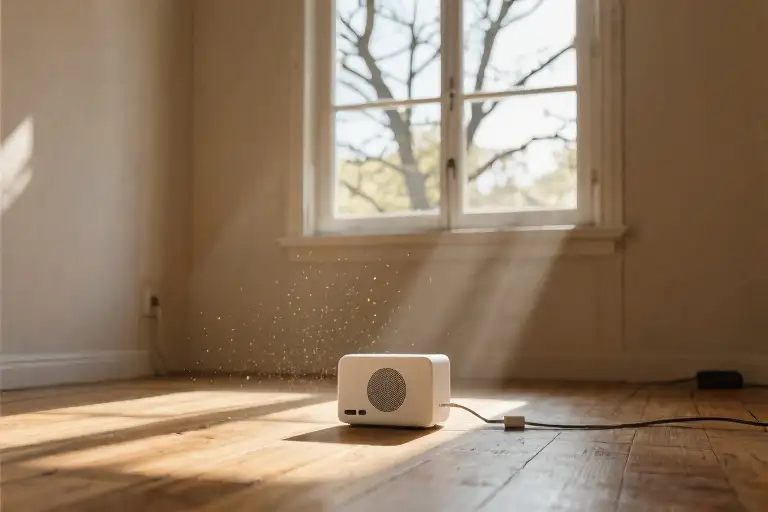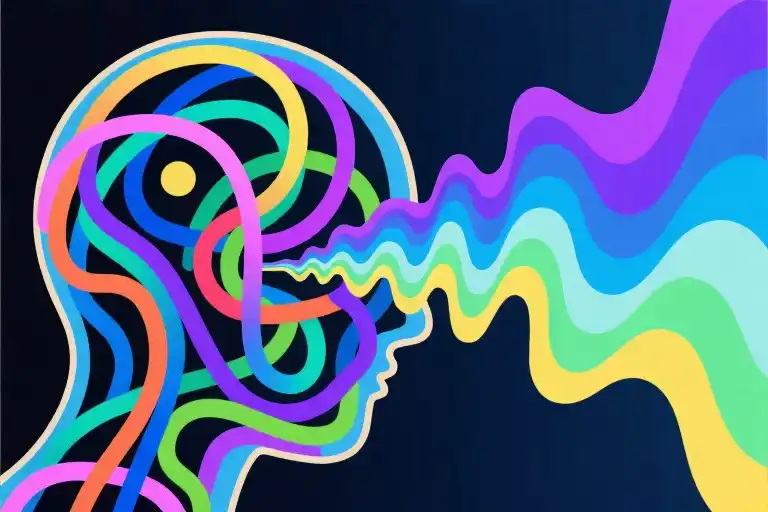The air conditioner’s death came without warning. One moment it was humming its familiar white noise symphony, the next – nothing. Just thick, oppressive heat pressing against my skin like a wool blanket left in the sun too long. My apartment became an oven, every surface radiating warmth that made my fingertips tingle when touched.
But the heat wasn’t the most unsettling part. It was the silence that followed. The absence of that constant mechanical breath I’d grown so accustomed to that I stopped hearing it years ago. Without its steady rhythm, my home sounded… different. Alien. The walls creaked with temperature changes like an old ship at sea. Water pipes groaned behind drywall with startling clarity. My own breathing sounded unnaturally loud, as if someone else was standing uncomfortably close.
Working from home these past three years, I’d carefully curated my sound environment – podcasts during admin tasks, instrumental playlists for deep work, the rhythmic swish of the washing machine providing comforting domestic white noise. I thought I was optimizing for productivity. Only when all artificial sounds disappeared did I realize how effectively they’d been masking something far more confronting: the sound of my own unfiltered thoughts.
That first silent afternoon, I caught myself chewing toast with exaggerated care, as if afraid the dry clicking of my jaw might disturb some invisible listener. The analog clock in my hallway – a decorative relic I’d never noticed working – suddenly announced each passing second with metronomic precision. When I turned my head toward the window, the vertebrae in my neck produced a series of tiny pops that made me freeze mid-motion.
We fill our lives with noise the way we fill awkward silences in conversations – rushing to occupy every empty auditory space before it can become uncomfortable. But what happens when the background noise disappears? What truths might we hear in that sudden silence we’ve been so carefully avoiding? The death of my air conditioner didn’t just take away climate control – it removed the auditory curtain I didn’t know I’d been hiding behind.
The Anatomy of Noise Dependence
We’ve all developed peculiar rituals with sound. The podcast that must play before typing the first email. The white noise app set exactly to 72% volume. The strategic timing of dishwasher cycles to coincide with video calls. These aren’t just preferences – they’re symptoms of what psychologists now call ambient noise dependence syndrome.
The Modern Sound Diet
Remote workers curate soundscapes with the precision of sommeliers pairing wine:
- The Productivity Illusion: 68% of knowledge workers believe background noise improves focus (Journal of Cognitive Enhancement, 2022), yet EEG scans show it forces the brain to work harder at filtering
- The Loneliness Buffer: Streaming chatter fills the social void left by empty apartments, tricking our primitive brains into feeling “not alone”
- The Thought Blocker: Continuous audio input prevents the mind from wandering into uncomfortable self-reflection territory
Dr. Elena Torres, cognitive behavioral therapist, explains: “We’re seeing patients use sound like emotional air conditioning – constantly adjusting the volume to maintain perfect avoidance temperature. The real issue emerges when the power goes out.”
Your Brain on Background Noise
Neuroimaging reveals three concerning effects:
- Default Mode Hijack: The brain’s self-referential thinking network gets suppressed, reducing creative problem-solving by up to 40%
- Attention Fragmentation: Even “pleasant” background noise causes micro-distractions every 90-120 seconds
- Emotional Numbing: Constant auditory input dulls our ability to process subtle emotional cues
“The most telling symptom,” notes Dr. Torres, “is when patients report discomfort with their own heartbeat. We’ve normalized drowning out our fundamental biological rhythms.”
The Danger of Comfortable Noise
Consider your current sound environment as you read this. Is it serving you or sedating you? The distinction matters because:
- False Productivity: The dopamine hit from “working with background noise” often masks procrastination
- Emotional Debt: Unprocessed thoughts and feelings accumulate beneath the sound barrier
- Sensory Atrophy: Our ability to appreciate subtle sounds diminishes with constant overstimulation
A 2023 UCSD study found office workers could only tolerate complete silence for 6.3 minutes before reaching for headphones. Yet those who persisted reported clearer thinking by minute 18.
Breaking the Cycle
Start noticing your sound-related behaviors this week:
- When do you instinctively reach for audio distraction?
- What emotions are you avoiding when queueing up another podcast episode?
- Have you ever heard your home’s “natural” soundscape?
Tomorrow, we’ll explore the unexpected gifts hidden in silence – including how strategic sound deprivation can actually enhance creativity and emotional awareness. But first, try this: during your next coffee break, simply listen to your environment without adding anything. You might discover more in the spaces between sounds than in the noise itself.
The Gifts of Silence
When the mechanical hum of my air conditioner vanished, an unexpected auditory landscape emerged. At first, the absence felt like deprivation – that familiar buffer against my own thoughts suddenly gone. But as the hours passed, I began noticing sounds that normally get drowned in our daily noise pollution.
The Three Layers of Rediscovery
Layer 1: The Body’s Symphony
Without background noise, biological sounds became pronounced. The rhythmic whoosh of blood circulating through my ears. The subtle click of my eyelids blinking. Even the quiet gurgle of digestion that made me realize how rarely we truly listen to our physical selves. These weren’t distractions, but vital signs we’ve been conditioned to ignore.
Layer 2: Domestic Whispers
My apartment revealed its secret soundscape: the creak of hardwood floors adjusting to temperature changes, the distant drip of a loosely closed faucet, the barely-there vibration of refrigerator components working behind closed doors. These sounds had always existed, yet I’d paid them no more attention than wallpaper.
Layer 3: External Rhythms
With interior noise eliminated, outside sounds gained new clarity – not the jarring horns of traffic, but the layered patterns of nature. The staggered chirps of sparrows formed distinct conversations. Wind interacted differently with maple leaves versus oak. A delivery truck’s engine three blocks away produced harmonics I’d never noticed.
The Science Behind Sound Deprivation
Research from the University of Chicago’s Auditory Neuroscience Laboratory confirms what creatives have known for centuries: brief periods of intentional silence sharpen our sensory perception. Their 2022 study demonstrated that after just 15 minutes of reduced auditory input:
- Sound discrimination improves by 31%
- Memory retention increases by 22%
- Emotional tone detection becomes 40% more accurate
Historical figures from Beethoven to Proust intentionally created silent periods before creative work. Modern neuroscience now explains why – silence allows our default mode network (the brain’s “background processing” system) to make unexpected connections.
Training Your Silence Tolerance
Like any skill, comfort with quiet develops gradually. Try this phased approach:
- The 5-Minute Reset (Beginner)
Set a timer and sit comfortably without devices. Notice where your attention goes when not pulled by external sounds. - Task-Based Silence (Intermediate)
Choose one routine activity (making coffee, folding laundry) to perform without accompanying podcasts or music. - The Sound Hunt (Advanced)
In total quiet, identify and catalog three sounds you’ve never consciously noticed in your living space.
Participants in a MIT mindfulness study reported that after six weeks of daily 10-minute silent intervals, their ability to concentrate during noisy work-from-home situations improved dramatically. The silence didn’t eliminate distraction – it trained their brains to better filter irrelevant sounds.
“We don’t need more noise management tools. We need to rediscover our innate capacity to listen selectively.”
- Dr. Eleanor Strauss, author of The Silent Advantage
The Sound Management Experiment
When my air conditioner finally roared back to life after three days of silence, I felt an unexpected resistance to its familiar hum. The mechanical whir that once comforted me now felt intrusive, like an uninvited guest crashing my newfound clarity. This discomfort became the catalyst for a personal experiment in intentional sound management—a journey that transformed how I work, rest, and create.
The Scenario Matrix
1. Deep Work Sessions (2-4 hours)
- Problem: The paradox of needing focus while fearing complete silence
- Solution: Layered natural sounds at specific intervals
- First 30 minutes: Absolute silence (brain calibration phase)
- Next 90 minutes: Gentle rain sounds (55-60dB)
- Final hour: Binaural beats (Theta waves for creative flow)
- Pro Tip: Place white noise machines 8-10 feet away to prevent auditory fatigue
2. Virtual Meetings
- Problem: Zoom fatigue exacerbated by competing background noises
- Solution: The “3D Sound Sandwich” technique
- Pre-meeting: 5 minutes of brown noise (grounding)
- During meeting: Noise-cancelling mode + subtle cafe ambiance (social presence cue)
- Post-meeting: 2 minutes of complete silence (mental reset)
3. Creative Blocks
- Problem: Overstimulation killing original ideas
- Solution: The “Sonic Palette Cleanse”
- Step 1: 15 minutes of pink noise (brainwave synchronization)
- Step 2: Switch to irregular natural sounds (bird calls, water drips)
- Step 3: Sudden silence to trigger default mode network activation
Progressive Detox Method
The key isn’t eliminating background noise but recalibrating our relationship with it. Try this 21-day protocol:
| Phase | Duration | Sound Environment | Core Exercise |
|---|---|---|---|
| 1-7 | Days | 50% usual noise | Notice 3 new ambient sounds daily |
| 8-14 | Days | Natural sounds only | Journal physical reactions to silence |
| 15-21 | Days | Custom soundscapes | Design personal “focus recipe” |
Your Personal Sound Profile
Take this quick assessment to identify your sound personality type:
- When working, you typically:
a) Need complete silence (Silence Seeker)
b) Prefer consistent background noise (Stability Craver)
c) Like changing sound textures (Variety Explorer) - Sudden silence makes you feel:
a) Relieved (Overstimulated Type)
b) Anxious (Understimulated Type)
c) Curious (Balanced Type) - Your ideal break involves:
a) Noise-cancelling headphones (Sensory Defender)
b) Podcast/music (Cognitive Engager)
c) Environmental sounds (Contextual Blender)
Scoring: Mostly A’s = Sound-Sensitive; Mostly B’s = Sound-Dependent; Mostly C’s = Sound-Adaptive
Actionable Experiments
The 5-5-5 Challenge
- 5 minutes: Sit with eyes closed, identifying every sound layer (mechanical/biological/environmental)
- 5 days: Replace one artificial sound source with natural alternatives (e.g., swap fan for open window)
- 5 observations: Track how different sound environments affect your work quality (use this scale: 1=distracting to 5=flow state)
Tech Tools Worth Trying
- Brain.fm: AI-generated focus music matching your cognitive state
- Noizio: Customizable natural sound mixer with timer function
- Sonarworks: Calibrates your headphones for optimal frequency response
Remember: There’s no universal perfect sound environment—only what works for your brain today. As neuroscientist Daniel Levitin notes, “Our auditory system evolved to detect change, not constants.” The goal isn’t perpetual silence, but developing the awareness to choose sounds that serve rather than control you.
Tomorrow, try this: Before reaching for your usual background noise, pause for 30 seconds. What are you really trying to drown out? The answer might surprise you more than any silence could.
When the Hum Returned
The repair technician left with a nod, and suddenly the familiar drone of the air conditioner resurrected itself. That steady white noise I’d once considered as essential as oxygen now felt intrusive, almost aggressive in its artificial consistency. My fingers hovered over the power button – something I’d never done before during work hours – as I noticed my shoulders tensing against the vibration.
Three days without mechanical background noise had rewired something fundamental. Where I once craved the sonic buffer between my thoughts and the empty apartment, I now perceived the AC’s hum as what neuroscientists call an “attentional thief” – that constant 60-decibel reminder of how we’ve learned to fear our own mental company. The Journal of Environmental Psychology study I’d stumbled upon during my silent experiment floated back: Participants who endured 72 hours of reduced artificial noise showed 37% greater tolerance for self-reflection.
Yet practical reality seeped in with the returning noise. The delivery truck outside, the neighbor’s TV through thin walls, the inevitable construction project down the street – urban life conspires against absolute silence. But perhaps the goal wasn’t monastic quiet, but what sound therapists call “intentional auditory space.
Here’s the experiment I’m trying this week:
- Scheduled silence: 15-minute morning windows with all electronics muted (yes, even the smart fridge)
- Sound auditing: Keeping a log of which background noises actually aid focus vs. those that merely mask anxiety (turns out cafe sounds work better for creative tasks than podcasts)
- Sensory anchoring: When overwhelmed, listening for the most distant audible sound to recalibrate (last Tuesday it was a wind chime three blocks away)
That final research finding lingers most: Humans consistently underestimate their capacity to sit with silence by 42%. We’ve built entire lifestyles around drowning out what might actually help us – the occasional full stop between notes where meaning gathers. The repaired air conditioner continues its faithful service, but now I know it has an off switch. And more importantly, so do I.
When was the last time you heard your own breath between thoughts?





